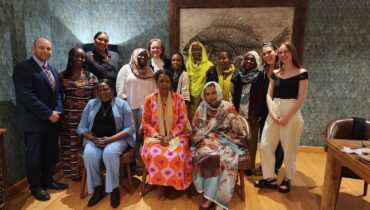This week, women mediators from across the globe are gathered at the United Nations to discuss the underrepresentation of women in formal peace processes. Women struggle to be heard by the parties in countries affected by conflict, they continue to be sidelined at the negotiating table, and they make up just 2% of mediators in major peace processes. Much focus, and deservedly so, is given to the two former challenges. Little focus is given to the latter. This article offers recommendations for increasing the number of women mediators in official peace talks.
More countries experienced violent conflict in 2016 than at any time in nearly 30 years. Given the devastating impact of conflicts worldwide, it is imperative that we develop more effective conflict resolution strategies. One way to do this is to look at the way we do mediation as a means to resolve conflict.
The mediation scene is overwhelmingly dominated by men. I will not claim that introducing more women mediators will lead directly to more effective resolution of conflict. Rather, I am presenting simple math. If you double the number of candidates you increase the chances of finding the best person for the job.
Furthermore, United Nations Security Council Resolution 1325 and subsequent resolutions mandate an increase in women’s participation in peace processes at all levels. If we, as mediators, are to have any credibility when we push the parties to have more diverse representation, we have to walk the talk ourselves.
Many women already mediate at the informal level. From Afghanistan to Nigeria, women leaders have engaged groups like the Taliban and Boko Haram, working as bridge-builders and mediating local arrangements. In fact, studies carried out by Georgetown Institute for Women, Peace and Security show that women are overwhelmingly involved in informal peacemaking. Why is it, then, that only 2% of mediators in all major peace processes between 1990 and 2017 were women?
Some might argue that it is difficult to find qualified women. However, recently, regional networks of women mediators have been established: FemWise-Africa, the Nordic Women Mediators, the Mediterranean Women Mediators Network, and the Women Mediators across the Commonwealth Network. ASEAN will soon be launching a register of women mediators in South East Asia.
The women in these networks have vast experience in the field of conflict resolution and peace and reconciliation. Among these women, there is Hanna Tetteh, former Foreign Minister of Ghana, involved in the peace talks in South Sudan; Norwegian Kristin Lund, the UN’s first and only female Force Commander to date; Catherine Samba-Panza, former interim President of the Central African Republic. The list goes on. It is hard to argue that it is too difficult to find qualified women.
Another challenge has been that mediation positions are usually not publicly advertised, which makes for an opaque selection process. Fortunately, however, the UN is making efforts in the right direction. Terms of reference for UN mediators were recently elaborated to create a fairer selection process. And this year the UN appointed a female Special Envoy to Myanmar, and a female interim Envoy to the Cyprus conflict.
The responsibility for increasing the number of women mediators does not only lie with the United Nations. It also falls to member states, who need to nominate more women for these positions. And we have to remember that the mediation world has broadened; the UN is not the only mediation actor out there. Other mediators – the EU, the OSCE, the AU, countries, NGOs – also share the responsibility to appoint women as Special Envoys to peace processes.
It’s not only about introducing more women. It is also about looking at how mediation is being carried out. Mediation traditionally depends heavily on high level personalities, mostly male, who carry a great responsibility on their shoulders. In this day and age, it is time to look at more innovative and modern working methods. Using stronger mediation teams, co-mediation, deputy Special Envoys are ways of adapting mediation work, to make it less dependent on one person, and spread the responsibility. I believe that this would also favor a more gender-balanced approach.
Last, but not least, the preconception that men of a certain age and political stature are most capable of carrying out mediation processes should be questioned. They are likely indeed capable, but they might not be the only ones. My own country, Norway, is currently facilitating two peace processes – in Colombia and in the Philippines. Until very recently, they were both led by women in their early 40s. These developments help to challenge our implicit biases and broaden our vision of leadership.
I believe the time has come to break out of deep-rooted patterns. The mediation field is ready to enter into the 21st century – a century where mediation is a team effort and where women and men are considered on an equal footing. Ultimately, it is not about gender. It is simply about the best person, or persons, for the job.
Elisabeth Slåttum, Norwegian diplomat, former Norwegian Special Envoy to the Philippine peace process between the Government and the Communist movement NDFP, and member of the Nordic Women Mediators network


